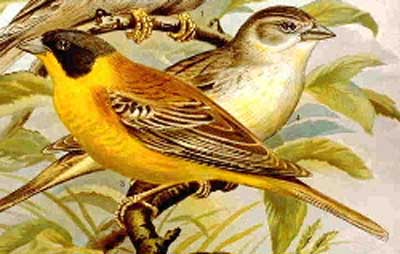Emberiza melanocephala Cladus: Eukaryota
Emberiza melanocephala Scopoli, 1769 Vernacular names
Annus I-(V) Historico-Naturalis p.142 The Black-headed Bunting, Emberiza melanocephala, is a passerine bird in the bunting family Emberizidae, a group now separated by most modern authors from the finches, Fringillidae. It breeds in southeast Europe east to Iran. It is migratory, wintering in India. It is a rare but regular wanderer to western Europe. Black-headed Bunting breeds in open scrubby areas including agricultural land. It lays 4-6 eggs in a nest in a tree or bush. Its natural food consists of insects when feeding young, and otherwise seeds. This bird is 17 cm long, larger than Reed Bunting, and long-tailed. The breeding male has bright yellow underparts, chestnut upperparts and a black hood. The female is a washed-out version of the male, with paler underparts, a grey-brown back and a greyish head. The juvenile is similar, and both can be difficult to separate from the corresponding plumages of the closely related Red-headed Bunting. The call is a soft zrit, and the song is a jerky zrit..zrit…zrit…srut..srut…srut. References * BirdLife International (2004). Emberiza melanocephala. 2006. IUCN Red List of Threatened Species. IUCN 2006. www.iucnredlist.org. Retrieved on 12 May 2006. Database entry includes justification for why this species is of least concern Source: Wikipedia, Wikispecies: All text is available under the terms of the GNU Free Documentation License |
|

